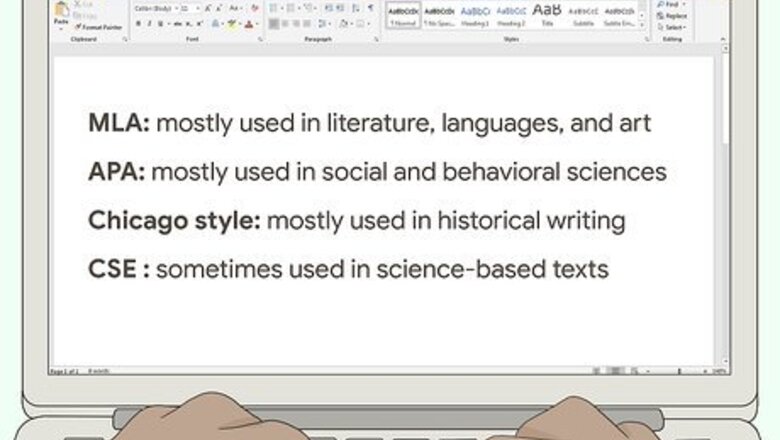
views
- Cite your sources. Always follow quotes or references to someone else's ideas with a citation.
- Write things in your own words. Don't use someone else's exact words and pass them off as your own.
- Never let someone else write your assignment for you. Using someone else's work as your own is plagiarism.
Using a Citation System
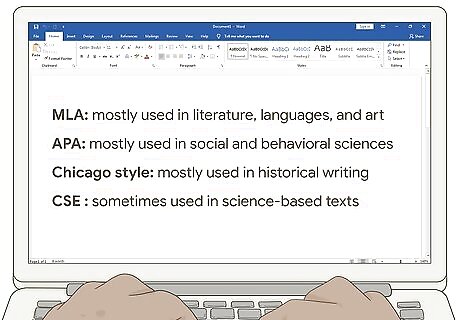
Choose a citation system or find out which one you are required to use. To properly cite references that you use in your writing, you will have to follow a specific citation style manual. Ask your instructor, publisher, or editor what style you should be using, or select one for your work based on the type of text you are producing. The most popular citation styles include: MLA (Modern Language Association) style, which is mostly used in texts surrounding literature, languages, and art. APA (American Psychological Association) style, which is mostly used in texts about social and behavioral sciences. Chicago style, frequently used in historical writing. CSE (Council of Science Editors) style, sometimes used in science-based texts.
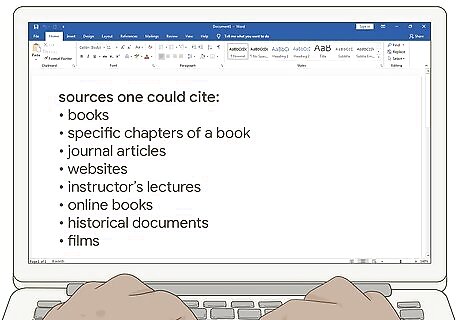
Refer to the latest edition of your citation style’s manual to cite sources accurately. The specific rules of a citation style can be hard to follow at first. Purchase, borrow, or download a digital copy of the most recently-published edition of your chosen style’s manual to avoid errors. Use the manual to accurately cite all the types of sources you use in your work, including: Books Specific chapters of a book Journal articles Figures Websites Manuals Instructor’s lectures Online books Historical documents Films
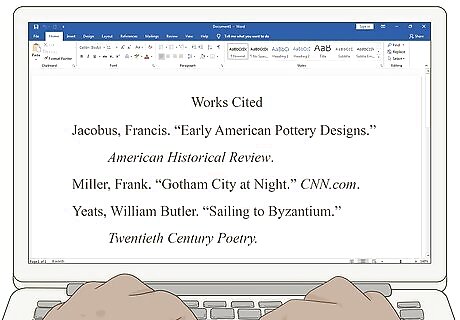
Compile a “works cited” list to include at the end of your writing. After all of your in-text citations are made and your writing is complete, you should put together a full, detailed list of the sources you’ve used. The format, order, and punctuation of these citations will vary between citation styles. Each style, however, requires you to include crucial information about your references, such as: The author’s first and last name, or the full names of all contributors to a work with multiple authors The title of the material cited. The date of publication, in full or just the year. The physical or online place of publication.
Featuring Citations Properly
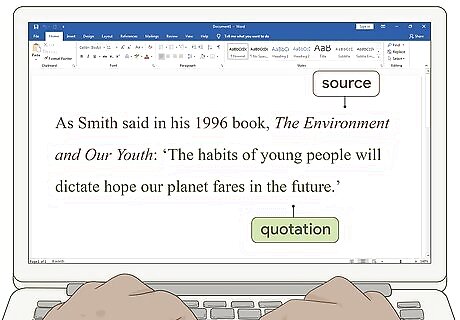
Identify a source and reiterate a part from it verbatim to make an accurate quotation. Quotations borrow the exact words from an original source to support an idea or argument. When adding a quotation to your text, identify the author and publication clearly and state your intention to use it. Include the quote in quotation marks, without any changes to the text. For instance, write: "As Smith said in his 1996 book, The Environment and Our Youth:'The habits of young people will dictate hope our planet fares in the future.'"
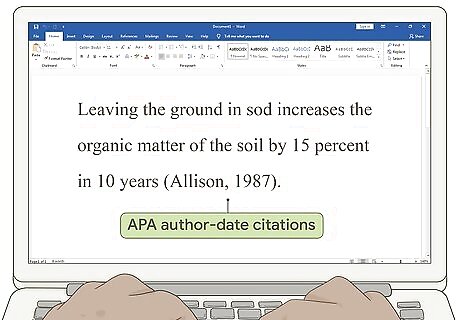
Follow direct references and quotations immediately with a citation. All of the main citation systems require you to attribute ideas to their original source as soon as you feature them in the text. The specific procedure to do this varies between styles but should always be done to avoid plagiarism. Follow the rules of your chosen style to make the in-text citation by including: The author’s name and page number of the material quoted, in parentheses after you refer to it. The author’s name and the date that the work was published. Superscript numbers next to the idea that was paraphrased, summarized, or quoted.
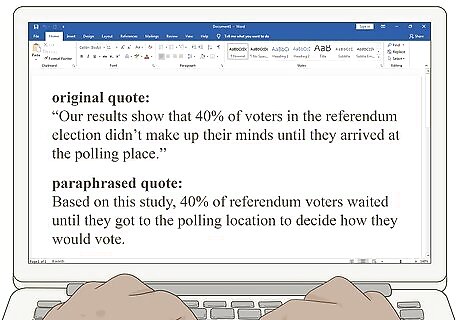
Change the sentence structure, language, and voice of a text when paraphrasing. Be vigilant about rewriting ideas taken from a section of source material so that your attempt at paraphrasing isn't actually plagiarism. Paraphrasing should restate the author's message in your voice, putting it into the context of your own text. Be sure to alter: The way the sentences are constructed in the source text. The source's vocabulary, by swapping as many words as possible with synonyms. The tone of the writing so that it is clear that you are writing in your own words.

Condense source material into a brief explanation to summarize it properly. To summarize a source text, identify the main ideas communicated in it and describe them efficiently. A summarization should be no more than 1/10 as long as the original text. Include the author, year, and title of the work. Do not use quotation marks to summarize source material.
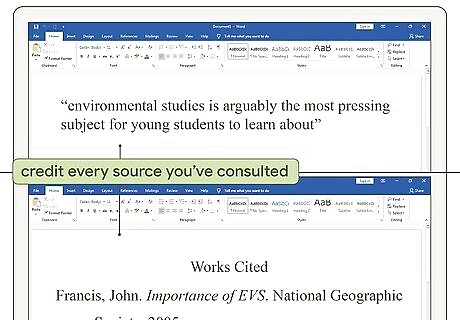
Cite specific ideas in your writing that are based on material you’ve read. To be safe, credit every source you’ve consulted for your writing, even if it is unclear how much your writing has borrowed from it. This will eliminate the risk of unknowingly plagiarizing someone’s work. It will also show that you are conscious of where you own ideas are coming from, which will strengthen your text. For example, if you state something like, “environmental studies is arguably the most pressing subject for young students to learn about”, you should cite an article you read about that topic the week before which makes the same argument.
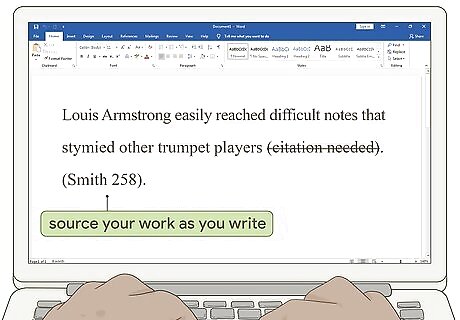
Source your work as you write it instead of adding citations later. An organized method of writing with help you avoid errors that might lead to plagiarizing. As you write the first draft of your text, add in-text citations right away so you don’t lose track of the works you’ve cited. Start compiling a “works cited” page right away that you can edit later. Citing sources right away will remove the stress of having to organize your references at the end of your writing process, which may make it stressful to meet your deadline.

Read a text carefully so you understand it before using it. Citing a source does not simply involve re-wording their work but comprehending it thoroughly and explaining it. Take the time to read and re-read your sources if necessary, then to explain their ideas in your own words. Your reference to the text should be placing it in the context of your own writing, not reiterating it as it was originally stated.
Creating Original Content

Don’t allow anyone to write your assignments for you. It is plagiarism to have someone write a text for you and then pass the writing off as your own. This applies if you pay for writing services, have someone write a text based on your notes or ideas, or have someone write part of a text for you. Write your text completely on your own or cite a friend or colleague as a co-author. In an academic setting, you will usually have to write your own work without collaborating with other students.

Get permission to cite material you wrote for other classes or publications. If you want to refer to a text you wrote in the past for a course or publication, you must first contact the person you submitted the work to. If the instructor or publisher agree that you can use this material in a new assignment, self-cite your work and get a copy of it to submit with your next text. Avoid borrowing too much from past work, which may take away from the integrity of your current text. Never re-submit or re-purpose a full text for a new writing assignment.
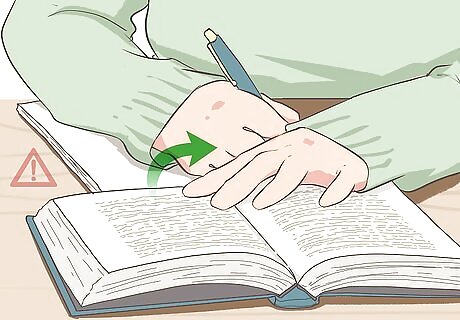
Do not copy another author’s citations and pass them off as your own. If you use a reliable source as a reference for your work, you are not entitled to cite the sources they used as if you read them. Citing one author’s work does not mean you are automatically also citing their sources and influences. Comprise your “works cited” list of sources you have read firsthand only. For example, if you quote a writer who refers to a Freudian concept, do not copy their in-text citation for the Freud publication or include Freud in your “works cited” list.

Avoid relying on plagiarism-detecting software to write a suitable paper. Some institutions use plagiarism-detecting software to scan texts when they are submitted, prompting many students and writers to use the same technology as a safeguard. Some software may falsely detect plagiarism or miss it completely, making it unreliable if used alone. Only use this kind of software to second check your work and be vigilant about avoiding plagiarism as you write. Free and paid plagiarism-check software is available online. Using this type of software may give writers a false sense of security, making them more prone to plagiarize inadvertently.

Start your assignments early to give yourself ample time to do research. Good research takes time, as do strong writing and effective sourcing. Avoid procrastinating on your writing assignments, which will add stress to your projects when the deadlines approach. Give yourself as much time as possible to consult a variety of sources, read them well enough to understand them, and feature them in your work responsibly.


















Comments
0 comment